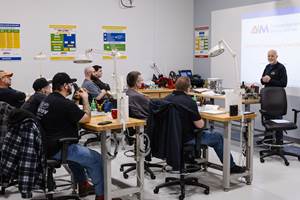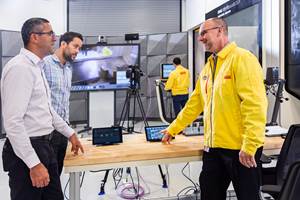Amerimold 2013 – Part 1: Workforce Development = Productive Citizens
You can't get a large group of American manufacturers in the same room these days without hearing about the shortage of skilled and motivated workers. So it should come as no surprise that one of the biggest ideas discussed at the amerimold 2013 tradeshow and conference this past week was how to capture the attention of young people, motivate them to pursue a career in manufacturing, and then train them so that they can perform the tasks that are required these days.

You can't get a large group of American manufacturers in the same room these days without hearing about the shortage of skilled and motivated workers. So it should come as no surprise that one of the biggest ideas discussed at the amerimold 2013 tradeshow and conference this past week was how to capture the attention of young people, motivate them to pursue a career in manufacturing, and then train them so that they can perform the tasks that are required these days. I am happy to report that great progress is being made in this area, and the evidence of this progress was on full display in Rosemont this week.
Perhaps you have already heard about Cardinal Manufacturing. If you have not yet heard of them, then you should immediately look up their video on YouTube. This is a high school program, where students are being taught about the art and science and business of manufacturing things in America. I will not go into too much detail about this program here – I do not want to spoil the surprise. But I can tell you that this is one of the most exciting and inspiring ideas I have seen in a long time.
Like any great idea regarding the development of our most precious resource, the youths of America, the key to this program is education. We are fond of talking about education in this country, but we do not always walk the walk. Many of the people I talk to in manufacturing have strong ideas about education, and these ideas usually include a negative opinion about college. These opinions have merit, but ultimately, I believe they miss the point. For the sake of further discussion, I offer the following refinements:
The mission of our education system in the US should be twofold. It should prepare each of our youths to engage and compete in the marketplace. Our economy is based on free market capitalism. All of us must learn how to buy and sell goods and services. That includes our own talents and skills and experience. In short, we all must learn how to be productive. For a significant portion of our young population this can be achieved by learning technical skills in places like technical high schools and community colleges. We all must dedicate ourselves to finding qualified students and then immerse them in a program that develops the talents required for a career in the art and science and business of manufacturing.
This will make them productive, but we must also prepare them to be citizens. Our system of government in the US is a democracy. We justifiably take great pride in our freedoms and our desires to be self-governing. This is what is meant by the expression, "life, liberty, and the pursuit of happiness." But freedom is not free. As citizens we must continuously engage in complicated and difficult issues. Our ability to engage in these issues is greatly enhanced by studying history, philosophy, science, and the arts. The purpose of studying these subjects is not necessarily to learn how to make a living, but rather to learn how to live a life in a free and self-governing society.
These two tracks of learning – learning how to make a living, and learning how to make a life – are complementary. They are self-reinforcing. When they are engaged in a balanced way, they are the truest expression of life, liberty, and the pursuit of happiness. The greatest product that any one of us can hope to produce is a steady and persistent up-slope in the trend of our nation’s productive citizens.
And to think that I realized all of this while attending the amerimold 2013 tradeshow and conference…
Related Content
Mold Maintenance Continues to Matter: Enhanced Training Program in a New Facility
I attended a MoldTrax mold maintenance workshop in 2019 and shared my experiences, and despite changes in ownership, the workshop's remarkable value endures, as discussed in a recent Q&A with the current leadership.
Read MoreHow to Use Continuing Education to Remain Competitive in Moldmaking
Continued training helps moldmakers make tooling decisions and properly use the latest cutting tool to efficiently machine high-quality molds.
Read MoreHow to Improve Your Current Efficiency Rate
An alternative approach to taking on more EDM-intensive work when technology and personnel investment is not an option.
Read MoreHands-on Workshop Teaches Mold Maintenance Process
Intensive workshop teaches the process of mold maintenance to help put an end to the firefighting culture of many toolrooms.
Read MoreRead Next
Reasons to Use Fiber Lasers for Mold Cleaning
Fiber lasers offer a simplicity, speed, control and portability, minimizing mold cleaning risks.
Read MoreAre You a Moldmaker Considering 3D Printing? Consider the 3D Printing Workshop at NPE2024
Presentations will cover 3D printing for mold tooling, material innovation, product development, bridge production and full-scale, high-volume additive manufacturing.
Read MoreHow to Use Strategic Planning Tools, Data to Manage the Human Side of Business
Q&A with Marion Wells, MMT EAB member and founder of Human Asset Management.
Read More





















